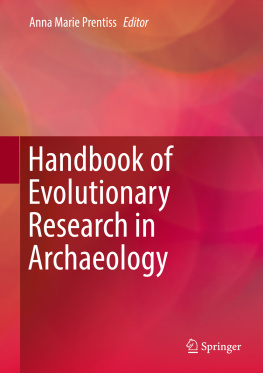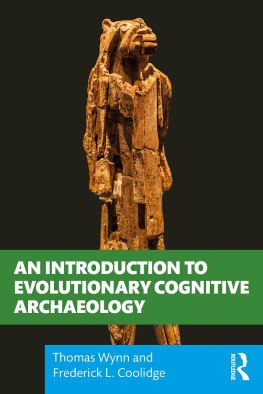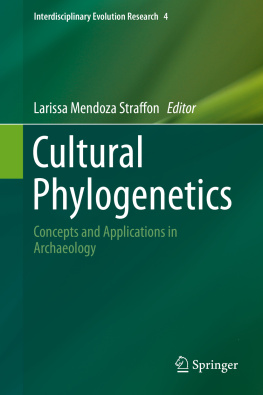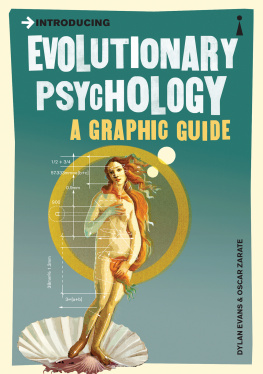Anna Marie Prentiss - Handbook of Evolutionary Research in Archaeology
Here you can read online Anna Marie Prentiss - Handbook of Evolutionary Research in Archaeology full text of the book (entire story) in english for free. Download pdf and epub, get meaning, cover and reviews about this ebook. year: 0, publisher: Springer International Publishing, genre: Romance novel. Description of the work, (preface) as well as reviews are available. Best literature library LitArk.com created for fans of good reading and offers a wide selection of genres:
Romance novel
Science fiction
Adventure
Detective
Science
History
Home and family
Prose
Art
Politics
Computer
Non-fiction
Religion
Business
Children
Humor
Choose a favorite category and find really read worthwhile books. Enjoy immersion in the world of imagination, feel the emotions of the characters or learn something new for yourself, make an fascinating discovery.
- Book:Handbook of Evolutionary Research in Archaeology
- Author:
- Publisher:Springer International Publishing
- Genre:
- Year:0
- Rating:5 / 5
- Favourites:Add to favourites
- Your mark:
- 100
- 1
- 2
- 3
- 4
- 5
Handbook of Evolutionary Research in Archaeology: summary, description and annotation
We offer to read an annotation, description, summary or preface (depends on what the author of the book "Handbook of Evolutionary Research in Archaeology" wrote himself). If you haven't found the necessary information about the book — write in the comments, we will try to find it.
Handbook of Evolutionary Research in Archaeology — read online for free the complete book (whole text) full work
Below is the text of the book, divided by pages. System saving the place of the last page read, allows you to conveniently read the book "Handbook of Evolutionary Research in Archaeology" online for free, without having to search again every time where you left off. Put a bookmark, and you can go to the page where you finished reading at any time.
Font size:
Interval:
Bookmark:
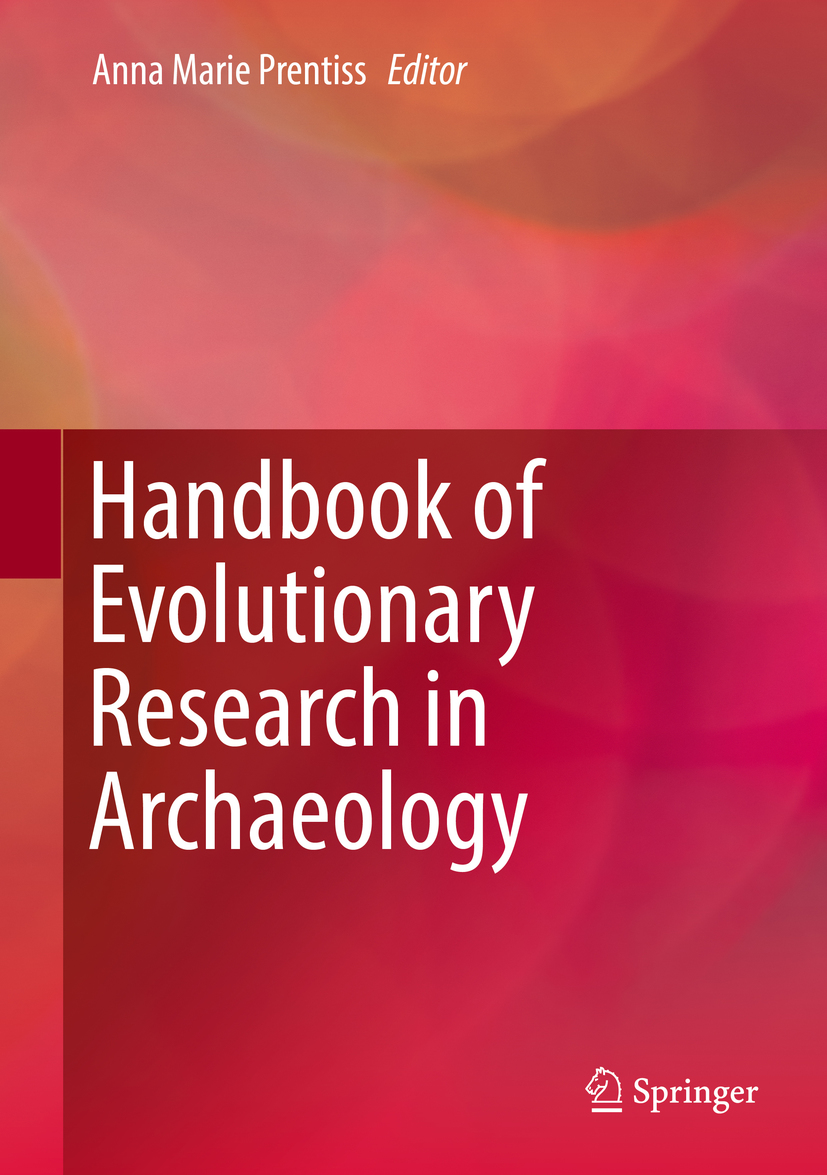

This Springer imprint is published by the registered company Springer Nature Switzerland AG.
The registered company address is: Gewerbestrasse 11, 6330 Cham, Switzerland
The Handbook of Evolutionary Research in Archaeology evolved from a series of discussions between the editor (Anna Prentiss) and the executive editor for Archaeology and Anthropology at Springer (Teresa Krauss). After meetings in Kyoto, Japan, and Vancouver, British Columbia, Canada, we agreed that this would be a productive effort, and the project was initiated. Teresa has subsequently played a significant role in developing the vision for this book and guiding it through its various stages including designing specific content, peer review, final submissions, and book production.
I am grateful for all the work by our international group of contributors including (in approximate order by chapter) Matt Walsh (National Museum of Denmark), Felix Riede (Aarhus University, Denmark), Sean ONeal (Aarhus University, Denmark), Nathan Goodale (Hamilton College, USA), Anne Kandler (Max Planck Institute for Evolutionary Anthropology, Germany), Enrico Crema (University of Cambridge, England), Cheyenne Laue (University of Montana, USA), Alden Wright (University of Montana, USA), Larissa Mendoza Straffon (Leiden University, the Netherlands), Erik Gjesfjeld (University of Cambridge, England), Peter Jordan (University of Groningen, the Netherlands), Charles Spencer (American Museum of Natural History, USA), Lisa Nagaoka (University of North Texas, USA), Kristen Gremillion (The Ohio State University, USA), Colin Quinn (Hamilton College, USA), Nicole Herzog (Boise State University, USA), Cedric Puleston (University of California, Davis, USA), Bruce Winterhalder (University of California, Davis, USA), Marc Abramiuk (California State University Channel Islands, USA), and Duilio Garofoli (University of Tbingen, Germany). Many of these scholars are early to mid-career, and I think this bodes extremely well for the future of evolutionary research in archaeology.
I am also very grateful to our two dedicated peer reviewers for the diligence in reading this lengthy collection and for their excellent and useful comments. Their work makes a big difference to the quality of the contents of this book.
I thank the University of Montana for awarding me with a year-long sabbatical that opened the time to write chapters and edit much of the collection. The sabbatical was partially funded by a fellowship from the National Endowment for the Humanities (grant RZ-230366-1). Any views, findings, conclusions, or recommendations expressed in the chapters authored by me in this book do not necessarily represent those of the National Endowment for the Humanities. I also thank the McDonald Institute for Archaeological Research at the University of Cambridge, England, (and especially Cyprian Broodbank) for providing me with a visiting scholar position during the sabbatical that facilitated writing time and offered a very stimulating academic environment within which to work. I thank (in no particular order) Matt Walsh, Cheyenne Laue, Enrico Crema, Erik Gjesfjeld, Sean ONeal, Charles Spencer, Bruce Winterhalder, Nathan Goodale, Jim Chatters, Tom Foor, and Ian Kuijt for many stimulating conversations in person and over email. Special thanks to Tanja Hoffman and Susanne Hakenbeck for support, friendship, and good conversations during my time in Cambridge.
Finally, I thank my family for their unwavering support and endless patience, while I travelled around the world developing this project (among other things) and, subsequently, spent long hours hidden away getting some writing done!
Research Data Policy: A submission to this book implies that materials described in the manuscript, including all relevant raw data, will be freely available to any researcher wishing to use them for non-commercial purposes, without breaching participant confidentiality.
The publisher strongly encourages that all datasets on which the conclusions of the chapter rely should be available to readers. We encourage authors to ensure that their datasets are either deposited in publicly available repositories (where available and appropriate) or presented in the main manuscript or additional supporting files whenever possible. Please see Springer Natures information on recommended repositories: List of Repositories .
General repositories for all types of research data such as figshare and Dryad may be used where appropriate.
Where a widely established research community expectation for data archiving in public repositories exists, submission to a community-endorsed, public repository is mandatory.
Persistent identifiers (such as digital object identifiers (DOIs) and accession numbers) for relevant datasets must be provided in the chapter.
The datasets generated during and/or analysed during the current study are available in the [NAME] repository, [PERSISTENT WEB LINK TO DATASETS]
Font size:
Interval:
Bookmark:
Similar books «Handbook of Evolutionary Research in Archaeology»
Look at similar books to Handbook of Evolutionary Research in Archaeology. We have selected literature similar in name and meaning in the hope of providing readers with more options to find new, interesting, not yet read works.
Discussion, reviews of the book Handbook of Evolutionary Research in Archaeology and just readers' own opinions. Leave your comments, write what you think about the work, its meaning or the main characters. Specify what exactly you liked and what you didn't like, and why you think so.

